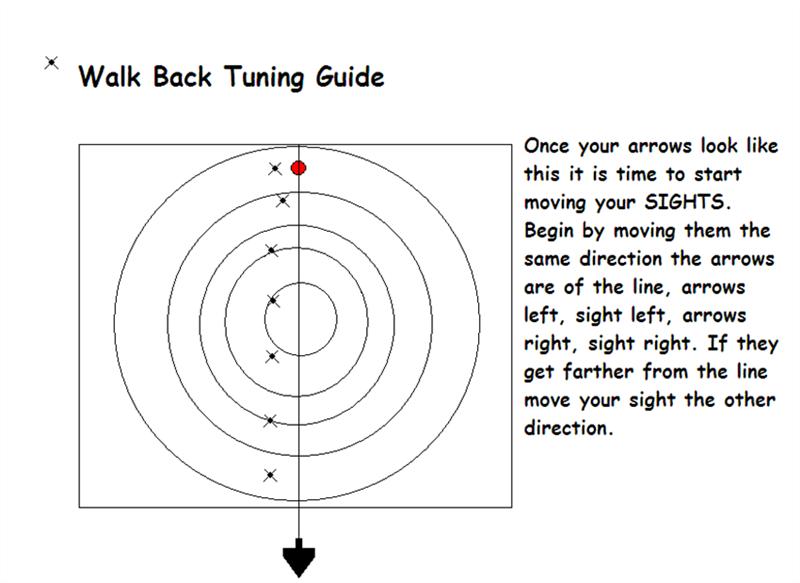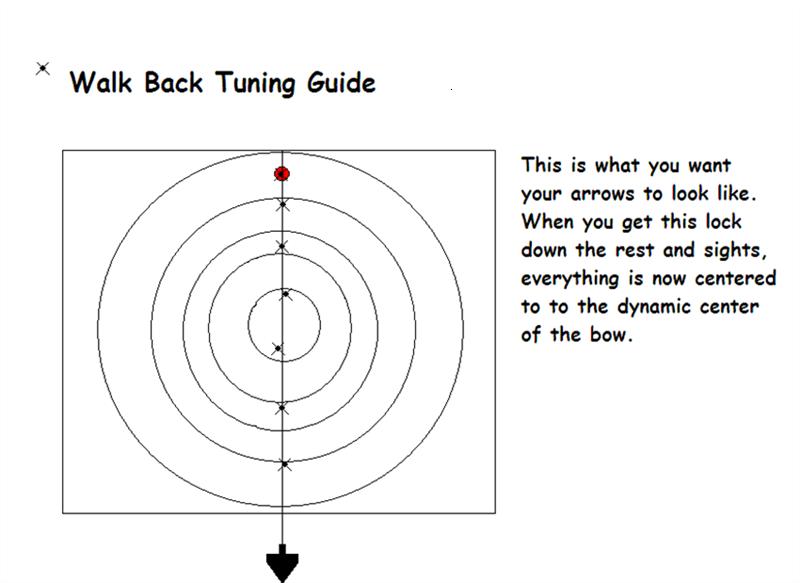Since the off-season has arrived, for most of us anyway, and the recent number of tuning related threads I thought I would post up on how to Walk Back Tune.
What walk back tuning does is find the perfect dynamic center of the bow. When you set up while the bow is at brace (rested) you are setting up everything (rest and sights) to the static center of the bow. Walk back tuning takes into to account the dynamic flexing (torque) of the bow during the shot to get the arrow to fly perfectly from center and then to line up the sights with that center as well.
I believe that walk back is superior to paper tuning and bare shaft tuning in that either of these only tell you what is going on at a given distance; while walk back covers much more ground and gives a better picture of what is actually happening over a longer distance.
Here is how we do it. Set the bow up like you would normally and then shoot in your 20 yard pin.
The set up:
Set the target up so that it is about eye level. Use a string and a plumb bob to hang a vertical line from the top all the way to the bottom. You can do the same thing with a level and a magic marker, just plumb the level and then mark one edge.
Place a small sticker, about 1 inch round, or draw a circle near the top of the target.
How it's done:
For the every shot you will ONLY use your 20 yard pin, every distance you shoot will be with your 20 yard pin.
1) Shoot from 20 yards, aiming at the small sticker or circle.
2) Shoot from 25 yards, aiming at the small sticker or circle.
3) Shoot from 30 yards, aiming at the small sticker or circle.
4) Shoot from 35 yards, aiming at the small sticker or circle.
5) Shoot from 40 yards, aiming at the small sticker or circle.
The longer the distance the better. If you have an area that will allow you to go 60 yards then do it, you can also go in 10 yard increments if you have the room. You need to get five arrows in the target minnimum tho, the size of your target may also be a limiting factor.
Now look at the arrows and make adjustments accordingly:




What walk back tuning does is find the perfect dynamic center of the bow. When you set up while the bow is at brace (rested) you are setting up everything (rest and sights) to the static center of the bow. Walk back tuning takes into to account the dynamic flexing (torque) of the bow during the shot to get the arrow to fly perfectly from center and then to line up the sights with that center as well.
I believe that walk back is superior to paper tuning and bare shaft tuning in that either of these only tell you what is going on at a given distance; while walk back covers much more ground and gives a better picture of what is actually happening over a longer distance.
Here is how we do it. Set the bow up like you would normally and then shoot in your 20 yard pin.
The set up:
Set the target up so that it is about eye level. Use a string and a plumb bob to hang a vertical line from the top all the way to the bottom. You can do the same thing with a level and a magic marker, just plumb the level and then mark one edge.
Place a small sticker, about 1 inch round, or draw a circle near the top of the target.
How it's done:
For the every shot you will ONLY use your 20 yard pin, every distance you shoot will be with your 20 yard pin.
1) Shoot from 20 yards, aiming at the small sticker or circle.
2) Shoot from 25 yards, aiming at the small sticker or circle.
3) Shoot from 30 yards, aiming at the small sticker or circle.
4) Shoot from 35 yards, aiming at the small sticker or circle.
5) Shoot from 40 yards, aiming at the small sticker or circle.
The longer the distance the better. If you have an area that will allow you to go 60 yards then do it, you can also go in 10 yard increments if you have the room. You need to get five arrows in the target minnimum tho, the size of your target may also be a limiting factor.
Now look at the arrows and make adjustments accordingly:

 I don't know if you have seen Nuts and Bolts' way of French Tuning, what he calls Modified French Tuning, I'll see if I can find that post on AT and post it here. If I remember right you could do it at 10 yards or less, I neve tried it so I don't know how reliable it is. I will PM Nutz and Boltz to see if he will let me post it here. Strictly for information, I have never used it myself.
I don't know if you have seen Nuts and Bolts' way of French Tuning, what he calls Modified French Tuning, I'll see if I can find that post on AT and post it here. If I remember right you could do it at 10 yards or less, I neve tried it so I don't know how reliable it is. I will PM Nutz and Boltz to see if he will let me post it here. Strictly for information, I have never used it myself.

Comment